Menu
Please click on a link to take you to each page.
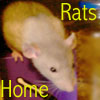
General Care
Personality/Habits
Lifespan
Nail & Teeth trimming
Baths
Introduction/Fighting
Quarantine
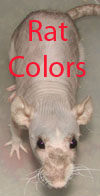
Colors & Markings
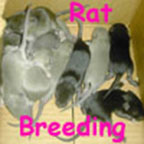
Sexing info
Pre-Breeding info
Pregnancy Info
Baby Info
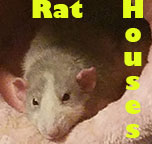


Health Tips
Eyes
Mycoplasma
Pneumonia
Temperature
Bugs
Veterinary Care
Abscesses & Tumors
Bumblefoot
Sprained ankles/Torn toenails
Wounds
Degloving/Tail injury
Aggression
Ears
Megacolon
Barbering
Old Age
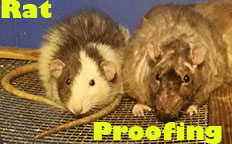
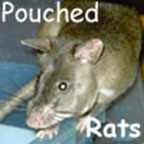

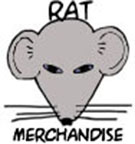

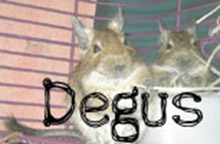
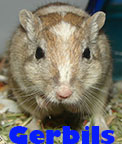
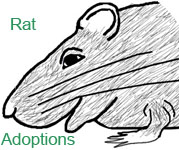
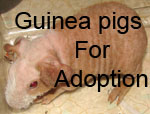
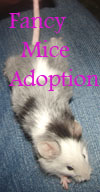
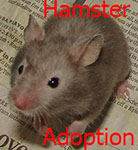

Please click on a picture to take you to each page
80stoysale.com HOME
Menu
Please click on a link to take you to each page.

General Care
Personality/Habits
Lifespan
Nail & Teeth trimming
Baths
Introduction/Fighting
Quarantine

Colors & Markings

Sexing info
Pre-Breeding info
Pregnancy Info
Baby Info



Health Tips
Eyes
Mycoplasma
Pneumonia
Temperature
Bugs
Veterinary Care
Abscesses & Tumors
Bumblefoot
Sprained ankles/Torn toenails
Wounds
Degloving/Tail injury
Aggression
Ears
Megacolon
Barbering
Old Age












Please click on a picture to take you to each page
80stoysale.com HOME
Menu
Please click on a link to take you to each page.

General Care
Personality/Habits
Lifespan
Nail & Teeth trimming
Baths
Introduction/Fighting
Quarantine

Colors & Markings

Sexing info
Pre-Breeding info
Pregnancy Info
Baby Info



Health Tips
Eyes
Mycoplasma
Pneumonia
Temperature
Bugs
Veterinary Care
Abscesses & Tumors
Bumblefoot
Sprained ankles/Torn toenails
Wounds
Degloving/Tail injury
Aggression
Ears
Megacolon
Barbering
Old Age












Please click on a picture to take you to each page
80stoysale.com HOME
Menu
Please click on a link to take you to each page.

General Care
Personality/Habits
Lifespan
Nail & Teeth trimming
Baths
Introduction/Fighting
Quarantine

Colors & Markings

Sexing info
Pre-Breeding info
Pregnancy Info
Baby Info



Health Tips
Eyes
Mycoplasma
Pneumonia
Temperature
Bugs
Veterinary Care
Abscesses & Tumors
Bumblefoot
Sprained ankles/Torn toenails
Wounds
Degloving/Tail injury
Aggression
Ears
Megacolon
Barbering
Old Age












Please click on a picture to take you to each page
80stoysale.com HOME
Menu
Please click on a link to take you to each page.

General Care
Personality/Habits
Lifespan
Nail & Teeth trimming
Baths
Introduction/Fighting
Quarantine

Colors & Markings

Sexing info
Pre-Breeding info
Pregnancy Info
Baby Info



Health Tips
Eyes
Mycoplasma
Pneumonia
Temperature
Bugs
Veterinary Care
Abscesses & Tumors
Bumblefoot
Sprained ankles/Torn toenails
Wounds
Degloving/Tail injury
Aggression
Ears
Megacolon
Barbering
Old Age












Please click on a picture to take you to each page
80stoysale.com HOME
Menu
Please click on a link to take you to each page.

General Care
Personality/Habits
Lifespan
Nail & Teeth trimming
Baths
Introduction/Fighting
Quarantine

Colors & Markings

Sexing info
Pre-Breeding info
Pregnancy Info
Baby Info



Health Tips
Eyes
Mycoplasma
Pneumonia
Temperature
Bugs
Veterinary Care
Abscesses & Tumors
Bumblefoot
Sprained ankles/Torn toenails
Wounds
Degloving/Tail injury
Aggression
Ears
Megacolon
Barbering
Old Age












Please click on a picture to take you to each page
80stoysale.com HOME
Hopefully your rats will be healthy their whole lives but it is very important to be aware that at some point in your rat's life they may need Veterinary medical treatment -you must be willing to make a commitment to giving your rat appropriate care.
Rats can develop many different types of illnesses or medical issues. IE: Tumors, Cancer, Respiratory illness, Heart disease etc.
Unfortunately accidents can happen causing injury such as a torn toenail, tail injury, broken or sprained bones or even deep bite wounds.
All Pet Rats are born with a lung infection called Mycoplasma, they just aren't always affected by it. Commonly flair ups can occur. (See Mycoplasma section).
Many Pet store rats aren't bred for health because they are bred for feeders for other animals.
Not all Vets see Exotic pets.
How to find a Veterinarian:
It is fastest and easiest to ask the Receptionist immediatly when you call "Do you treat rats?" and if they don't, then continue calling down the list until you find one who does.
Once you find a Vet who will treat rats it is up to you if you want to continue calling down the list to see if there are other vets that will treat rats, or if you want to go with the first one you find.
If you continue calling down the list and find several who treat rats, then you can ask how experienced they are, ask about payment plans and office visit costs.
Sometimes generic and brand name medications prices vary so it is a good idea to inquire on options.
For many medical diagnosis the Veterinarians will suggest running certain tests that may or may not answers questions about the issue, making them aware of your financial situation can help them advise you on the nessasary actions to take.
* All too often i hear of people who claim their Vet's offices will not work out payment plans and they do not have the money for treatment so they refuse to take their animal to the vet. Denying your animal needed medical attention is animal cruelty, if you do not have the money or are unwilling to get the animal treatment, please call a local shelter or Rescue and explain your situation and see if they are willing to help get the animal appropriate treatment.
*Many Veterinarians will accept payment plans
*Care Credit and Pet insurance are sometimes available for payment options.
Please seek Veterinary care if your pet needs it!
Rats eyes should be shiney in appearance and not dull in color.
Rats mucus is a reddish/Brown color, it is called Porphyrin.
Porphyrin should not be confused with blood.
Blood is a dark red color, Porphyrin is reddish/brown.
Rats can have mucus/Porphyrin discharge from their eyes and nose.
It is produced in the Porphyries glands behind the rat's eyes.
Overproduction of Porphyrin can be caused by stress or illness.
Porphyrin discharge is usually increased if your rat has breathing trouble, Pneumonia, Mycoplasma flair up or are elderly.
A Little porphyrin from time to time is normal.
Excessive discharge or discharge around a rats nose could be a sign of illness.
*If you notice your rat has discharge from their eyes or nose, wash the rats eyes/face with warm water and wipe clean with a damp washcloth.
Most rats trim their own nails but sometimes when ill or elderly they stop trimming them as frequently.
This can cause the nails to become sharp and long, which could cause an injury or a scratch to themselves while grooming.
Trim their nails, as needed.
Dirt, dust, bedding, hair, eyelashes or whiskers could potentially cause irritation and Porphyrin discharge from the eyes or nose.
A Rat's nose should be dry, a wet nose can be a sign of illness.
*If your rat has a wet nose, you can dry it with a cloth or towel.
Rats sneeze frequently and more than other animals. Occasional sneezing is normal, excessive sneezing with discharge can be a sign of illness.
New environment sneezes are fairly common and not always a cause for concern.
Rex and Hairless rats have curly whiskers and tend to sneeze more than regular furred rats because the whiskers are curly and can curl to tickle their noses
Sometimes the whiskers will curl to tickle a nostril.
The whiskers can also bounce around as they walk which can make them brush against the nose and causing more sneezing.
Dull or cloudy eyes can be a sign of Cataracts.
Cataracts are usually noticed as a white film or area over the center of the Pupil.
Cataracts can be caused by a small scratch to the eye or from old age.
Most of the time treatment is not necessary as the rat can live just fine with it.
If the rat appears to be uncomforatable, upset or in pain they should see a Vet.
Eye injuries can occur in rats from debris in the eye, injury from fingernails, fighting with other rats, sinus issues, injury from something they encountered etc..
*Debris:
A Squinty, somewhat closed eye can be a sign that some debris could have gotten into the eye.
You can look into the rats eye and see if you notice any obvious debris.
On rare occasions it is possible Hair, dirt or bedding could become stuck inside or underneath the eyelid. This can cause the rat's eye to swell or get irritated.
You can Flush out the eye by using saline solution or by placing the rat's eye under warm (Not to cold or hot) running water and massaging lightly to try to dislodge any object.
If they eye or area appears swollen laying warm tea bags over or around the area may help reduce swelling.
If a rat's eye gets scratched or punctured applying ointments on it can help save the eye.
If the eye is injured to deep or drys out it can swell and protrude the eye out of the socket. If Very severe trauam has occured the eye can become detached and fall out.
Many eye injuries and conditions -Scratched eyes, dull eyes, cloudy eyes or small eyes (One eye is squinted smaller) can be treated with Terramycin, Neomycin or other "Mycin" ointments.
Vetracyin is a wound spray commonly sold at Farm stores that can be used to treat eye injuries. Be sure to get the bottle that states it is for wounds/eye injuries. It can be purchased over the counter.
Typically using the ointment can improve the eye within a few days.
Occasionally a rat can damage their eye from another rat stepping on them or running into something sharp. Make sure the environment and cage is safe from sharp or protruding objects they could hurt themselves on.
In some instances if a rats eye is damaged or has fallen out, the rat's eyelid will start to close over the damaged eye socket area on its own within several weeks. This is especially true for very young growing ratties.
If a rats eye gets damaged severely they may need to have an Enucleation surgery. Enucleation is where they remove the rest of what remains of the eye and stitch the eye area closed.
A rat can live with one eye quite well, in some cases it may take a few days to get used to everything, but in a lot of instances the eye was so damaged before surgery they had very little if any vision out of the eye already, so they already have had time to learn to be one eyed.
If possible for Enucleation surgery ask the Vet to stitch the eye area from the inside and to get disposable stitches. Stitches on the outside can cause swelling, pulling on the wound if the stitches get too tight, or can be ripped out by scratching.
A rat who has a damaged eye, closed eye or small eye can sometimes tilt to the side a little bit to make seeing easier for them.
*My Experiences:
Fraggle came to live with me as a just weaned baby who had lost an eye. His eye socket started closing on its own with the eyelids slowly covering his missing eye.
I cleaned his eye area and face area daily to make sure the area was kept clean and no debris got lodged inside until the wound healed closed on its own. After it closed on it's own I no longer had to clean discharge from the area and he could get around and clean himself all on his own.

Psy came to live with me with an already damaged eye. I took him in to get Enucleation surgery, The Vet stitched him up from the outside and inserted some antibacterial gel in his eye area and he was allergic to it, which caused his injury not to heal and caused serious oozing. I brought him back and he had to have the area flushed out thoroughly and be restitched. He almost immediately started looking better and he healed up wonderfully.
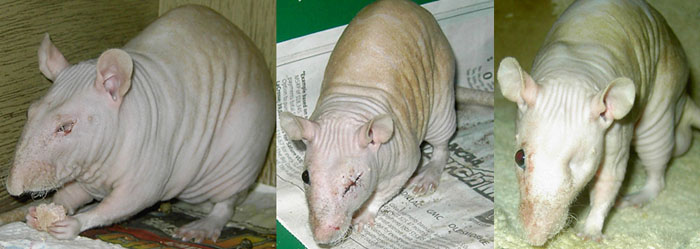
Zoomer was a very unique guy. When born his momma got a little carried away cleaning him and he got his toes on one foot and the tip of his tail nibbled off. That didn't slow him down one bit. At about a year old his eye clouded over and started bulging out a little bit. I immediately went to investigate and noticed some eye mucus in his eye so i tried to clean it out and put some eye ointment (Neomycin) in his eye to ease the pain. The next day it was still bulging so I went to wash his eye again as he was leaking porphyrin discharge and as I cleaned him up his eyeball popped right out of the socket onto the floor. I was a hysterical mess, Zoomer didn't seem to notice much. I scheduled an appt. for an Enucleation and Zoomer had surgery to stitch the area closed. He recovered wonderfully.
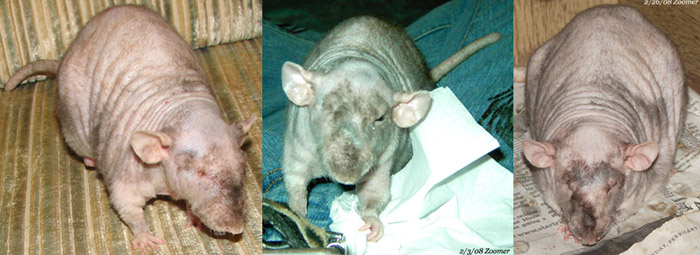
I've had several other ratties who suffered eye injuries before weaning, likely from Mom, Dad or other babies accidentally stepping on them.
A dirty cage covered with germs and feces
Dusty or harmful bedding.
Pine bedding contains harmful Phenols that burn rattie lungs and cause scarring and scabs to form inside the lungs.
Pine and Cedar bedding is not safe for any animals.
Carefresh or similar brands claim they are dust free but can still contain a high amount of dust.
Drafts from windows, Doors, Heating or cooling vents, Air conditioners and fans can cause respiratory issues or Mycoplasma flair ups.
Rats acquired from rat breeders are likely to be healthier than pet store acquired ones. Most pet stores don't acquire Rats for pets and buy from people who breed them for Feeders for other animals. Make sure to ask questions at the pet store before purchasing your rat to make sure they have knowledgeable staff, if you have rats at home already bringing in a sick one can have devastating consequences to your current ratties.
If you notice your rat has a wet nose, continue to dry the nose throughout the day for them.
This Treatment was recommended for my male rats 4 months and older.
This treatment was for rats 1 LB up to 1 1/2 LBS.
*Your Rats may not need this high or low of a dose of medicine.
To use a Nebulizer, fill up the cup with a 2.5 Mg. bottle of Albuterol solution and plug in and turn on.
Then hold the breathing tube or children's mask over the rat's nose & mouth and let them breathe it in twice a day for 5 minutes.
The solution will last for several uses before having to be refilled -roughly 3 days depending on how many doses and how many rats are using it.
The Nebulizer is quite loud, and some rats are a bit scared of it.
To get Albuterol solution you will need acquire it directly from your Vet, or your Vet can write you a prescription for you to pick it up from a Pharmacy.
Human inhalers don't work well on animals because when humans use the inhalers we inhale and hold it in our lungs for a few seconds and then exhale -rats don't hold it in they just breathe normally so they hardly get any solution in their lungs.
However if your rat is having trouble breathing and you have a human inhaler on hand, you can give the rat one puff to help them. The human inhaler puffs tend to only help for about 10-20 minutes, but sometimes will be enough to stabilize their breathing for a short period of time.
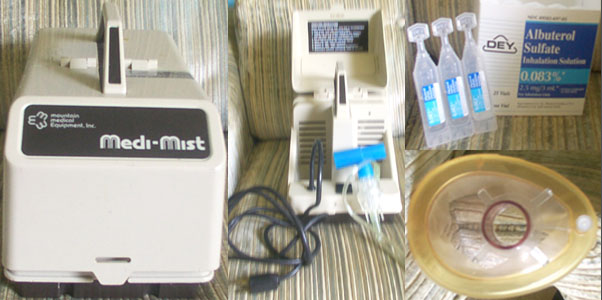
Common breathing problems can be caused by the air being dry.
Air purifiers and Humidifiers usually have fans in them which move the air around, these can cause your rats to become cold, if they are too close to them.
Vaporizers put out hot steam and if too close to the rats could burn them.
Setting these appliances at least 5 feet away is a good idea.
DO NOT use PINE or CEDAR bedding!
Pine & Cedar bedding is extremely harmful to rats. The wood contains phenols and can have toxic effects on rats respiratory systems. (Pine and Cedar are softwoods)
Rats housed with pine or cedar shavings have been known to have excess Porphyrin discharge from their eyes and nose, and have serious difficulty breathing.
Cough Suppressant medicine suppresses the symptoms, prolonging the condition, while Cough Decongestants loosen up the mucus and phlegm allowing it to be discharged from the body.
For example: If the package says for a human not to take more often than once every 4 hours -do not dose the rat more often than that.
Also look and see if the medicine sets a time frame of how long it lasts. (such as 4 hours, 8 hours etc.)
Observe the rats behavior, usually breathing improvements can be noticed within 10-20 minutes. If the breathing improves on the next dosage you can consider upping the dose to .15 cc.
Another good place to consult about rat medications is RMCA.org drug chart
However they can have cold like symptoms -but that is likely due to other respiratory problems such as Mycoplasma, Pneumonia or other illnesses or factors in the rats environment -such as smoke, dirty cages with strong urine/Ammonia or poor ventilation.
Since a lot of times Vets are unable to find the cause of the rats sneezing or wheezing they commonly may say your rat has a cold -but this is usually due to the fact that they have no exact cause to tell you for the illness. So, they need to find a "Name" to call what your rat is being treated for.
If a human has strep pneumonia, they have a very high fever, a bad cough, and various other respiratory symptoms -they are more ill than a case of Strep throat -(strep Pyogenes).
If you have Streptococcus Pneumonia stay away from your rats, if you are the only caregiver for your rats -find another person to take care of them, contact with your rats can cause them severe illness and probable/possibly death.
If a Human has Strep Pneumonia typically after taking Doctor prescribed medications for 1 to 3 doses they are typically not contagious to others or the rats any longer. Please ask your Dr. as some causes are more severe than others.
Rats can overheat in warm weather and have heatstroke.
Rats can freeze in cold weather and get hypothermia.
How to tell if your rat is dehydrated:
*On warm days I have had many rats who loved to walk over in front of the fan, stand up and sway back and forth! Furry rats tend to like fans much more than hairless, but I did have one Hairless rat, Trip that absolutely loved dancing in front of the fan.
*I had a hairless rat, Sid who loved to find a heater vent to sleep near on cold days.
* "Vita drops", are "high potency multivitamins for hamsters, rats, mice & gerbils." (available at pet stores.)
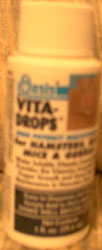
Treatments:
Make sure to especially soak all wood materials in very hot water or run them through the dishwasher.
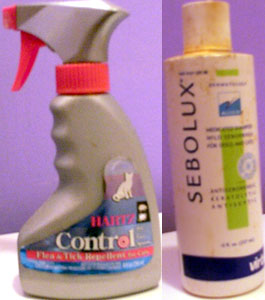
You can get it at www.countrysupply.com or a few other stores online, it usually costs under $5.
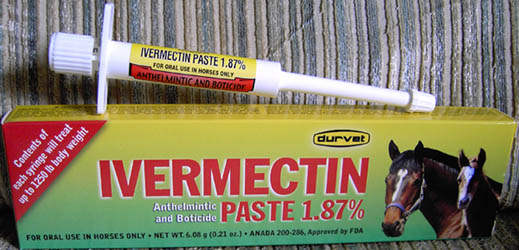
Ivermectin comes in a box, the box reads "Ivermectin Anthelmintic and Boticide paste 1.87%."
Inside the box is a syringe filled with enough paste to treat up to a 1250 LB. horse.
To use:
Empty the whole syringe into a small container (a film canister or small pill bottle.)
Mix up the paste with a toothpick very thoroughly.
Dab a toothpick into the paste and dose a small grain of rice size for an adult size rat. For smaller rats use a slightly smaller dose.
Do not use too much, you can overdose your rat.
You can try to get the rat to lick the paste off of your finger or mix the paste with applesauce or yogurt or even smear the paste onto a cookie.
Treat the rat on day 1, day 8 and day 15.
Store the unused paste in a leak proof container, it can be stored on the shelf or in the refrigerator.
What is an abscess?
An abscess is a small pus filled lump which can be located anywhere on a rat.
So, you noticed a lump on your rat and are wondering what to do?
Things to look for:
Please seek medical attention as soon as you notice a lump and get the appropriate care to insure your pet the best quality of life.
Abscesses can be treated quite easily at home if you are familiar with them.
Basically, to get familiar with them you will need to watch what the Vet does, and then if you feel confident and knowledgeable enough to try it yourself, you can give it a try, if you have another abscess appear in the future.
Please consult a vet if and when possible.
If you are not experienced or are a bit skittish around needles or wounds please do not attempt to treat your rat at home. Bring the rat to the vet.
For first timers dealing with abscesses, i would suggest bringing the rat to the vet and watching the vet procedure, so you can perform an abscess drain in the future if necessary.
Most abscesses heal up quickly with proper care and cleaning, Abscesses tend to keep reoccurring if not cleaned and cared for properly.
Healing time depends on the size of the wound and could take as little as a few days or a month or longer, depending on the severity of the infection.
If an abscess has a severe infection a Vet may need to prescribe antibiotics to speed up the healing process.
You will need Rubbing alcohol, a medical needle, cotton balls and/or gauze.
Squeezing the abscess area can cause the skin to become slightly red and irritated.

Having tumor removal surgery can provide your rat with a longer, happier life.
Mycoplex is a blend of Coriolus Versicolor & Coriolus cordyceps Mushrooms. Commonly referred to as Turkey tail mushrooms. Small doses of this mixed with the rats water or with their food can help reduce tumor growth. Starting the Mycoplex treatment as soon as possible after noticing the lump is best.
Some herbal stores do sell Turkey tail & Mataki mushrooms from time to time -both known to help respiratory problems and slow tumor growth, so if you are able to acquire them that way -or by picking or growing them yourself that works as well (As the brand name Mycoplex can be a bit spendy).
Let the mushrooms dry, grind them up in a grinder, and mix 1/4 Tsp with food or water. Mixing the mushrooms with applesauce, pudding or yogurt works well. If mixing with food, it needs to be put in some sort of food everyday, which can be a bit bothersome, so i usually give my rats two water bottles, one with mushroom water and one with regular water. The mushroom sediment does tend to settle a bit, so the bottle may need to be shaken a few times during the day, and if not ground fine enough may clog the mouthpiece.
Tamoxifen/Maxigen:
Some people have had success adding Tamoxifen/Maxigen -Shark cartilage to the Mycoplex dose. Give 1/5 dose twice daily for 2 weeks than once daily for 1 more week. Many people do not like using this product due to the fact it is Shark cartilage.
Grape Seed Extract helps Prevent Heart disease. It is also a cancer deterrent, which neutralizes cells that cause formation of cancer/tumors. It is also known to fight skin disease, slow cataracts, lessen allergy symptoms and slow aging.
Unfortunately i have no idea where to acquire this product.
Dried apricots & Red seedless grapes have cancer fighting Beta carotene. Grapes help shut down the growth of abnormal cells.
Benign tumors usually can be removed successfully with surgery and aren't always life threatening.
Malignant tumors tend to grow rather rapidly and can quickly damage nearby tissues and organs causing the rat to have health problems.
A lot of the time Malignant tumors can not be removed since they are near or embedded with vital organs.
Things to know about tumor/mass removal surgery:
Some Vets will not operate on more than one tumor at a time.
Having the incision stitched from inside out can help the stitches hold better, and make them harder for the rat to remove.
It has also been suggested that glue and staples make a hematoma less likely to occur.
This is when the body tries to fill in the empty space of the rats body.
The area will appear to be a lump and can be filled with pus, liquid and blood.
To help heal a hematoma faster, if possible, wrap the area with a bandage to apply a small amount of pressure. In most instances hematoma's will absorb back into the body within a week's time.
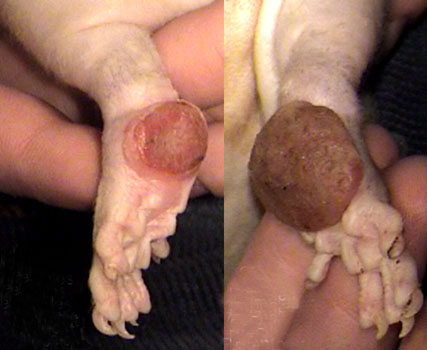
Bumble foot is another name for Ulcerative Pododermatitis.
It is a bacterial infection usually caused by Staphylococcus Aureus.
Bumblefoot is a foot problem that is on the bottom pad on the back of a rat's foot. (usually only on the back feet)
It is caused by rats walking on hard surfaces, wire cages & unclean living conditions.
It is also suspected that Bumblefoot can be caused due to the rat having sprained or injured their legs/feet earlier in life.
*We suspect this was the case with my hairless rat, "Sid." He sprained his ankle, then it healed and the next week he sprained his other ankle (He was not the most skilled climber) and then about 2 weeks later the bumbles appeared.
Bumblefoot is very hard to treat and usually can not be cured.
Medicines can be prescribed to help heal the wounds but they are usually unsuccessful by themselves.
It is referred to as Bumble foot because of the sore like bumbles that appear on the feet, the sores tend to bleed from time to time, and are commonly misdiagnosed as tumors.
Bumblefoot is most common in birds & Guinea pigs.
Bumblefoot should be cleaned once to twice a day, everyday with Nolvasan solution or other wound cleaning solution -This is an absolute must!
Hairless rats need lots of soft bedding materials.
The bumbles can get sore and worn away from normal walking and may bleed from time to time.
*My Rat, Sid was always getting paper stuck onto his bumbles, so you frequently saw him running about with newspaper feet. :)
Surgery to remove the rats bumbles from the feet is an option but is only viable in certain cases.
Bumbles can be very hard to remove surgically as the rat may not have enough skin around the area to properly close the incision.
Bumbles have also been known to form again only days or weeks after surgery.
Some people have had some success in decreasing the bumble wounds, by using the below 3 step process.
*My Rat "Sid" was given "Clavamox drops" (Amoxicillin) to be given orally to try to help fight the Bumblefoot infection from the inside, but "Sid" got ill from the medicine causing diarrhea and his appetite to decline, so we had to stop using the medicine.
The Blu Kote can be found at some feed stores or can be ordered online from the RMCA website.
You may have to call a few feed stores before finding one that carries the Blu Kote, Blu Kote is a product used on horses hooves.
Blu Kote is blue and comes in the U.S.A in a yellow bottle with an applicator tip. In the U.K. it is purple & comes in a spray bottle.
It is very important to try to keep the Rat, rats feet and rats area clean to prevent further infection.
The Blu Kote will stain everything, your hands, your rats feet, fur, body & towels blue or purple.
There are other products with Blu in the title but you want the "Blu Kote."
*I tried the Blu Kote on Sid, at first it made the bumbles harden up and look more like scabs than soft tissue and it was hard to tell how healthy the tissue was because it was so discolored blue for the Blu Kote. After about 3 months I stopped the treatment and Sid's feet became soft again. Also his tissue began looking healthier and peeling off. The Vet said his feet looked much healthier after I discontinued the Blu Kote treatment and to just keep soaking/cleaning his feet everyday with the Nolvasan solution to prevent the infection from spreading and killing off more tissue.
This Treatment will need to be done by a Vet.
Veruco freeze comes in an aerosol type spray can.
To make spraying the solution on the feet easier you may want to wrap cardboard or some sort of wrap around the feet to make it spray only on the bumbles and not on the healthy skin or flapping tails.
Spray onto the bumbles and cover them completely with the spray. You can freeze the skin different depths depending on how much you use.
The frozen bumbles will be cold to the touch for several hours and sometimes days.
The skin on the bumbles will start to deteriorate and peel away. You can help remove the extra skin if possible, the best way i have found to remove the dying tissue is to wash the rats feet under running water and gently rub the bumbles, the loose skin will usually fall away on its own.
Be careful and don't remove the peeling skin before it is necessary, it may cause bleeding.
*My Rat Sid, received 5 freeze treatments and then we decided it was not working, at first it appeared to be decreasing the size of the bumbles, but after the third treatment the bumbles began to grow larger again, and by the 5th treatment we decided it best to stop the treatments. We think maybe if we would have stopped at less treatments and possibly spaced them apart farther the treatment may have worked better.
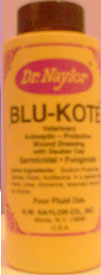
(Available at most vets & some farm/feeds stores -such as Fleet Farm.)

If your rats toenails or injury (Specifically leg injury) starts swelling you can run the rats foot under cold water to reduce swelling and if they will let you put a cold compress on their injury this will help as well. If your rat will not tolerate cold water or a cold compress you can get a towel wet and cold and let them lay on it for a while. Most rats also enjoy playing with ice, so if the rat has an injury on their front hands giving them ice will allow them to get their hands cold and can help.
*My rat, Sid sprained his ankle, he limped around for about a week, using mostly his other 3 legs, then the next week he sprained his other ankle! His ankle and foot got very red and a bit swollen and he would squeak when we touched his foot, he still ran around everywhere and recovered fairly quickly.
*I Once had a rat, Squatter who was sleeping and he started having a bad dream and kicked his foot out, he kicked it into a wood door on my headboard and it got very, very swollen (About 4 times the normal size) and appeared infected. I brought him to the vet and they said it looked like he would never recover and might have permanent damage to his foot. They said they could do an expensive x-ray but that even if they confirmed his foot was broken or sprained they didn't really have anything for us to do for him, as far as treatment. Well, Squatter spent most of his time lying down for the next 2 days, hardly walking around, we soaked his foot in Nolvasan solution several times a day and tried to wrap it in gauze the best we could. Squatter was walking on his foot again after about a week, but the foot remained swollen and reddened for about 3 weeks.
Rats, especially when babies, are very active and love to chase, tackle and pin one another.
Occasionally things can get out of hand and a rat ends up with a big bite.
If the Bite is really bad, injuring deep into the skin, a visit to the vet may be needed.
Be sure to clean the wound regularly and keep the rat clean.
Bite wounds have a great potential for infection as bacteria can be transported under the skin from the rats teeth during the bite.
You do not want to risk getting an infection, it can be very dangerous.
Clean the wounds with wound cleaning solution or Nolvasan solution. Hydrogen Peroxide can be used but is not recommended since it kills both dead and healthy tissue. (If you use Hydrogen peroxide be sure to rinse with water after a few minutes or dilute with water before disinfecting.)
If the rat has lost hair during the fight, their hair will grow back if the wound is properly cared for and is small.
Large wounds can leave scars and permanent hair loss growth in certain areas.
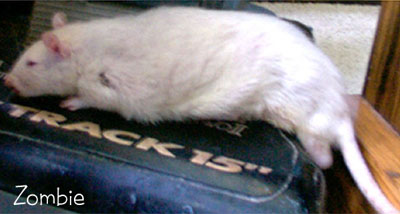
Degloving is when a part of your rats tail breaks off from being pulled to hard.
Parts of the tail can break completely off or be left only partially connected, turn black and blue or the skin can fall off only leaving bone and muscle exposed.
Never pick a rat up by their tail!
Never swing the rat around by the tail!
Never pull on the rats tail!
Also degloving can happen if the rat gets their tail caught in between cage bars or caught on something in the cage or play areas.
If you need to get a hold of the rat very quickly to prevent escape or injury try to grab for a foot rather than the tail.
If your rat experiences a degloving or tail injury, be sure to clean the wound with wound cleaning solution, such as saline solution, Nolvasan Solution, Chlorhexidine, or Hydrogen Peroxide diluted with water.
Most rats who suffer from a degloving or tail injury NEED to be seen by a Vet immediately.
In some cases the tail may need surgery, stitches and/or amputation.
Antibiotics will most likely be needed to prevent infection from starting or spreading.
A rats tail is directly connected to the spine, and if a serious tail injury is left untreated infection can set in and proceed into the spine which would cause great pain, discomfort and eventual death.
If you leave a tail injury untreated an infection might start and spread throughout the rats body causing Gainge green and other bacteria infections which could result in the rats death.
Rats come from all types of backgrounds and sometimes will show aggression to humans if they have been abused or mistreated.
Aggression in rats is much more common in poorly bred rats such as rats bred for feeders.
Sometimes loud unexpected noises can startle your rat and they may bite.
To avoid getting bitten, always make a noise or tap on the side of the cage to show your rattie you are there. Do not to sneak up on sleeping rats, you may startle them. It would be quite scary to be sleeping and suddenly have a giant monster grab you and you awake to be moving through the air.
When you first bring a new rat into the home, they may act scared and weary and occasionally bite.
Baby rats/just weaned rats will nibble more (Nibble -not drawing blood) as they are getting used to life and their surroundings and learning, this is normal behavior and typically is not a sign of aggression.
There are many forced socialization methods that can be used to help socialize your rat.
A few Forced socialization ideas:
Rats can get ear infections.
A common sign your rat may have an ear infection, is if you notice a head tilt -otherwise known as Wry Neck.
Pink eyed rats commonly will sway their heads from side to side because they have poor day vision and this helps them focus. Swaying is usually normal, but shaking can be attributed to an ear infection.
Other signs of infection are frequent shaking of the rats head and/or digging in their ears frequently with their feet.
Ear infections can cause the rat to scratch around their ears, which could cause scratches, scabbing and bleeding around the ears.
Ear infections can also cause the ears to have excessive wax build up and cause the ears to smell foul.
In certain instances the rat could scratch at their ears so frequently that it could puncture or injure their eardrums causing the ears to bleed and have trouble clotting.
If you notice excess wax in your rats ears you should clean them with a q-tip or a cotton ball.
If you notice a head tilt you should bring your rat into the Vet asap to get some medication. If an ear infection is left untreated the infection can spread through all the sinus cavities. Head tilts should be treated as soon as noticed, if they are left untreated for too long the rat may stay tilted and never fully recover.
On occasion it has been known for severe respiratory infections (Pneumonia/Mycoplasma)to spread through the nose and ears and cause an ear infection.
A common prescription for ear infections is an oral dose of Baytril and an ear drop ointment called Baytril Otic.
Most ear infections can be easily treated with ear drop antibiotics prescribed by a vet.
When putting ear drops in your rats ears, hold their head still for several minutes and try to massage the medicine into the ears.
They love to shake their heads and spray you in the face with the medicine!
It is important to keep your rats ears clean to prevent infection, and dirt from getting or becoming trapped inside the rats ear.
Rats ears should be cleaned frequently to prevent excessive wax build up and infection.
When cleaning rats ears, you want to clean out the dead skin and wax.
There are a few ways you can clean your rats ears:
A few things to be aware of to help prevent Ear infections are:
*My Experience with an eardrum puncture. I had one rat "Sativa" who started having a bit more ear discharge/wax then usual coming from his ear. I started cleaning his ears out daily. After about a week of the increased amount of wax discharge, I awoke one morning to find him, with blood coming from his ear, his blood was not clotting properly and was coming out in blood clumps. He was continuously shaking his head which would spray blood all over the place. We rushed him to the vet who confirmed he had an ear infection and he had stuck his foot so far in his ear trying to clean it, he punctured his eardrum. The vet gave us "Tresaderm" ear drops to drop into his ear twice a day for 4 weeks. We also had to clean out Sativa's ears once to three times a day as needed. For the first week his ear discharge still had hints of blood in it. After 2 weeks the blood was gone, but there was still a lot of wax build up, so his ears still needed cleaning everyday. Sativa recovered but did have excessive ear wax/discharge in his ears for the rest of his life, so he needed frequent ear cleanings once to three times a week.
My Experience with Head tilt/Wry neck -Respiratory related. I had a rat "Raindrop" whose lungs were compromised with a severe respiratory infection -Mycoplasma & Pneumonia -due to bad Genes in her bloodline. She was being treated for both. We got the infection to subside but her lungs were so scarred and compromised from the congestion she continuously was having respiratory problems. We noticed her starting to have a head tilt, we put her on med's and treated her for months with little improvement. She straightened out a bit but was crooked for the rest of her life.
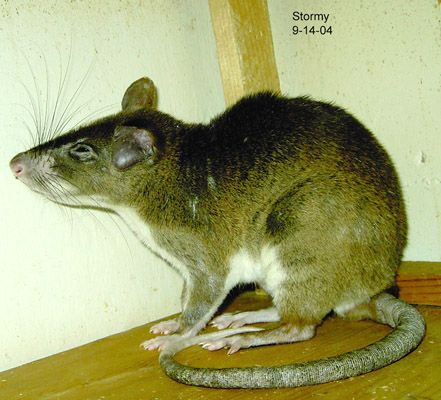
I personally haven't heard of them occurring in regular rats but my Gambian Pouched rat, Stormy developed an ear hematoma.
At first i noticed Stormy's ear was becoming very swollen, i thought she might have pinched it in between something or possibly an abscess could have been forming -i tried to puncture her ear with a needle as the ear appeared to be filled with pus -however only a tiny small amount of pus would drain out and the ear was becoming more swollen.
I did some research on line and found some pictures of dog hematoma, and Stormy's ear appeared to be the exact same thing.
So, I made a vet appointment for Stormy, and she had to have surgery on her ear. The Vet cut the ear down the center to drain out the pus that had filled inside. Then the Vet sewed the ear downward on both sides of the slit. That would allow the ear to continue to drain -connecting stitches would not have allowed it to drain. Stormy was also prescribed Baytril for a week. After 10 days the stitches were removed.
Stormy's ear had a lot of scar tissue that was created by the hematoma, it appeared wrinkled for the rest of her life.
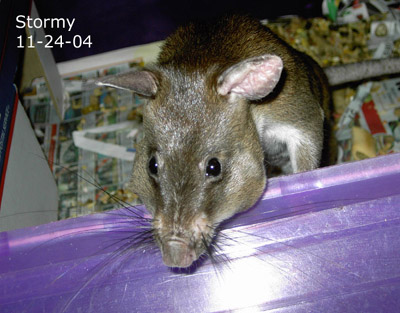
Megacolon is when an animal develops an enlarged Mega colon / Large Intestines.
Mega colon can be genetically passed down from Parents and other relatives.
Rats with Megacolon to be known in their bloodlines should NOT be bred.
There are two types of Megacolon.
Genetic Mega colon presents itself from breeding Blaze marked rats to blaze marked rats, Dalmatian (White with black spots) to Dalmatian or Dark eyed whites to Dark eyed whites. (All of these are referred to a high white markings)
To avoid producing rats that are at risk of developing Megacolon it is best to not breed Blaze to Blaze, Dalmatian to Dalmatian or Dark eyed white to Dark eyed whites (No high white breeding to each other)
Genetic Megacolon will not affect every rat in the litter, it can affect typically 1 to 3 in the litter depending on the color markings of the babies. (Example: a Black colored rat would not develop it)
It is also possible that Megacolon may not pop up in every litter the same mating pair produces together.
If a mating pair produces any babies with Megacolon it is best to re pair them with different mates or to retire them from breeding.
Some signs of Megacolon are:
Most animals will not live very long with Megacolon and will suffer and have a very poor quality of life, the kindest option is to have the rat euthanized.
Some people have treated Megacolon with minimal success that can prolong the rats life a little longer.
Treatment requires feeding the rat a special diet of soft foods and giving the rat Enemas to help bowel movements.
Giving a rat an enema can be quite difficult to insert the saline/enema fluid filled syringe properly. It can also stress out the rat considerably. it will be very smelly and feces will leak out. It can be very difficult to know when the blockage subsides which in most cases it probably won't be able to be passed and will remain blocked. Enemas and megacolon in general could also cause rectal prolapse from the continued pushing/force of trying to expel the feces. The most humane option is Euthansia. Mega colon can be painful causing stomach discomfort pain, cramps, bloating, blood in the feces and can cause other health issues within the digestive tract from built up bacteria from the feces being present for extended periods of time. Acquired Megacolon can happen at any age but is extremely rare and is typically caused by the rat ingesting bedding, plastic or non food substances that get stuck somewhere along the digestive tract causing a blockage. Acquired Megacolon is not genetic and can not be passed on to the babies.
Acquired Megacolon is more likely to be able to be treated with surgery to remove the blockage if the blockage is removed in time before the other digestive tract organs become extended, stretched, malformed or ruptured. The surgery is quite expensive and invasive and Euthansaia is typically the more humane option.
*Rumors/internet misinformation suggest that breeding any Blaze (High white) marked rat is taboo, this is not the case when you know the genetics and follow the simple rule of not breeding them together. Breeding a blaze or high white rat to a solid color is the best option to produce megacolon free rats.
*Another rumor/internet misinformation is that if you acquire a blaze or high white carrying rat that Megacolon could happen later in life, this just isn't the case as genetic mega colon almost always presents itself before weaning age and is extremely rare to present itself at a later age. There should be very minimal genetic megacolon concerns about acquiring a blaze marked rat as a pet, it is very unlikely that an issue will ever occur.
Barbering is when your rat chews off their hair in certain areas of their bodies by chewing it off.
Power grooming is when your rat is over grooming themselves, causing hair loss.
Most commonly rats will barber themselves on their necks, & wrists.
Rats can barber themselves if they are sick or scared. (such as they might over groom themselves on their arms, you don't know why and then a few weeks later a tumor or lump appears on their arm.)
Rat's may also do this out of stress due to recent cage, cage mates, environment, food or litter changes.
If you notice your rat chewing off their fur, another possibility could be bugs, such as lice, mites or fleas.
A few things to do to help try to persuade your rats to stop power grooming or barbering is when you notice them doing so or notice patches or hair loss clean the area with wound cleaning solution, bathe them, and put cortisone on the area.
Rats tend to live 1 1/2 to 3 years.
If you have a rat live to be 2 years old you are considered lucky, if you have a rat make it to 3 years old you are considered very, very lucky. A rat does not necessarily have to be "Old" to die from old age type symptoms, as sometimes they- like humans, can age differently.
A few signs of old age are:
They can also make loud gasping, gagging sounds. Occasionally when really struggling to breathe you will hear a clicking sound coming from the rats throat.
Hind leg issues can come in different levels.
Some rats will occasionally tip over when walking.
Some rats will get turned about quite easily and have trouble determining where they are trying to go.
Some rats will learn to cope with the loss of their back legs and learn to drag themselves around quite effectively.
Others will be overwhelmed with the lack of mobility and go down hill.
Stretch out the rats legs, slowly bend at the knee, (sort of like the riding a bicycle movement) rub the rats legs gently massaging the muscles, this will help the rat maintain circulation in their legs, hopefully helping them to maintain some use of them.
When rats start experiencing old age symptoms it is important to make their environment safe and adaptable for their current condition -such as a lot of elder rats have trouble climbing so make sure food and water is available on lower levels so they will be able to eat and drink even if they can not climb to the higher levels. Also make sure ladders and shelves are sturdy so they don't slip and fall.
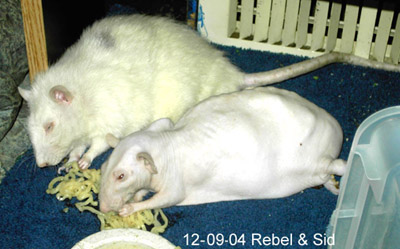
*Sid's Story: Sid was a hairless Dumbo male at about 1 year of age he developed Bumble foot and we tried many methods to try to cure it without any success, Sid was barely affected by his bumbles and got along quite well. At about 2 years of age he started experiencing hind leg paralysis, this made him very unmotivated and depressed. He stopped eating dry hard foods and would only eat soft foods. He would rarely drink on his own and when he did, he was so dehydrated he would drink for several minutes trying to re-hydrate himself. We started feeding Sid applesauce and water through a syringe. Sid also would eat yogurt drops and Raman noodles on his own, if in small enough pieces. I would feed him about 4 syringes full of applesauce about 3-4 times a day -depending on how much i had seen him eat on his own each day. After about a week of syringe feeding him, Sid finally developed enough strength in his front arms to be able to start pulling himself around again. After he was able to pull himself around, his appetite increased, although he still was only eating mostly soft foods, he improved and lived happily for another 4 months. At 2 years 4 months of age, Sid's health and appetite began decreasing again, he began to get very skinny, with his bones protruding the skin, he appeared to be rather bloated, he continued pulling himself around and eating up until his last day. On his last day he stopped eating and drinking all together and was breathing so heavily it was very difficult to try to syringe feed him, he passed away later that day.
I tell this story to inspire others that in some instances there is something you can do, if we had not pampered and cared for Sid when he first developed hind leg paralysis he would not have learned to cope with his disability and would have passed away, but since we fed and watered him and cared for him, he held on and lived another 4 happy months.
If the rats will eat the mushrooms fresh or dried out whole then you can feed them that way, otherwise you can grind them up in a grinder and mix them with applesauce.
Medication can come in many forms, such as concentrated liquid, tablet form and reconstituted liquid.
Liquid medications are the easiest to administer and can be given several different ways.

It can cause fetal development problems, retardation, adversely affect bone and tooth growth & other serious problems.
But if Baytril or Doxycycline is all your Vet has available and the rat is in a life or death situation, by all means it is up to you to use the medicine or not. Using the medicine for a day or two until another type of medication can be ordered by the Vet should be alright.
Here are a few suggestions on how to transport your rat to the Vet:
If the rat is going to be in the carrier longer than an hour, it is important to provide drinking water.
Some Vets will suggest that your rat not eat before surgery, but rats do not have a gag reflex so in most cases it is alright for them to eat beforehand.
Please do not euthanize any animal unless it is absolutely necessary.
Please, Do not take the decision of putting an animal down lightly!
Please, Do not use home euthanasia methods! Most of these methods are untested, can be faulty and can cause the animal to needlessly suffer. Please use a trained experienced vet.
Preferably use a vet who will let you hold your rat throughout the whole euthanasia process, as opposed to a vet who will take your animal away to a back room where you can't be sure how the animal passes.
Please try to treat the rats medical condition if at all possible before making the decision of putting them down, Rats are full of perseverance, i have seen many of rats look like they were on the brink of death and than make a full or partial recovery.
If your rat is still eating, drinking and mobile than the euthanasia decision should be put off until the condition worsens.
Your animals lives are in your hands, please make the best decision you can.
In some cases if you have a lot of rats and suddenly a bunch of them become ill and you are unsure as to what the illness is, a necropsy is a good idea, so you can properly treat the remaining rats.
Having a necropsy done usually entails, that your rat will be sent off to a lab, (Usually a University) to determine the cause of death.
The tests can be pricey and in most cases you will not get your rats remains back.
Most commonly humans will be allergic to the dead skin or dander in the rats hair, sometimes allergic reactions can come on suddenly. Sometimes humans will start sneezing suddenly after having the rats for a while, this may be because your rat has dandruff or the bedding your rat is on has a lot of dust which has gotten onto your rat. In most cases humans can take over the counter or prescription allergy medications and can still live peacefully with their furry friends.
If you are unable to treat your allergic reactions to rats and it is hard to live with them you can always get hairless rats!
A Rash can be quite common when handling your rats, most of the time the irritation is caused by your rats toenails being long or sharp and it causes your skin to become red and causes small bumps. The rat's tail can also sometimes irritate the skin. The "rat rash" as I like to call it usually goes away after about 20 minutes, washing your hands and sometimes applying lotion helps also. If the rash gets worse or causes you trouble you can always wear long gloves or long sleeved shirts when handling your rats to help prevent getting a rash.
The knowledge and information on all of my rat pages is based on personal experience or is general information I have collected from other rat owners and may not be true in all cases.
I am putting this disclaimer, as recently I have been receiving numerous emails trying to disprove some of the information contained on these pages.
If I find information others are telling me, to be true or feel the information I have provided on these pages may be misleading or not contain vital information, I do update/edit the information. However, please consult a Vet when and if necessary or possible to ensure your rat receives the best care.
I also want to point out that my pages are to help fellow rat pet owners and the information contained on these pages does not necessarily relate to a breeder views.
Email: DiscoPanth@gmail.com
Please visit all my Pages!